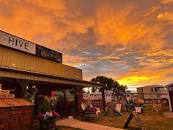
Whenever I get the chance to visit other provinces, I find myself gravitating to smaller towns. Last week, I was travelling through southern Alberta on a public-speaking tour. One of the places where I’d been invited to speak was Nanton (population 2,000), about an hour’s drive south of Calgary.
While there, my host invited me to lunch at a new eatery in town called The Hive. It was part vendors’ shop and part truck-stop café. Inside I was introduced to owner/operator, Kristen Hall.
“Welcome to The Hive,” she said. “It’s what’s buzzing in town.”
I rolled my eyes and groaned.
“It’s always a good idea to start your visit with a laugh,” she said. “Enjoy your stay.”
Before long I’d wandered well back into this country consignment store and lost myself in an array of paintings, pottery, jewelry, homemade clothing, folk art and books all created locally and presented in a bright, uncrowded and attractive setting.
Every Canadian village and town wishing to showcase its talent, products and services, ought to have a place like this, I thought, to help us get back on our feet after the pandemic.
“We’re a hub to support small businesses, help them showcase, expand and succeed,” owner Hall told me.
Back in the early 1970s, when I first travelled to western Canada, I landed in Saskatoon, working in the audio-visual department at the University of Saskatchewan. One of the first projects the department threw in my lap was a university outreach film.
Our job was to travel to a cluster of small towns in the eastern part of the province, interview residents (farmers, merchants, teachers, municipal politicians, homemakers) and determine what made small towns tick.
It was a time when the both national railways had decided that they could deliver products and services more efficiently by highway and air transport than by rail; so CP and CN began ripping up railway lines all across the Prairies – killing small towns in the process.
“Find out – despite the loss of a railway line – what makes a town live or die,” we were mandated. “And pinpoint what community spirit really is.”
After scores and scores of interviews, we deduced that a small Prairie town could lose its railway line, and even its grain elevators, but if it could keep its farm implement dealership, its place of worship and its curling rink, it could likely survive the loss of other vital infrastructure.
Some years ago, I’d learned the history of Nanton, the town I was visiting last week. The community was established around farming and ranching, but it had a unique asset – a source of spring water with a tap by the main road where travellers could stop and refresh themselves with a drink.
The Calgary Herald published a story in 1964 that the best drinking water in the world could be found in the “town of the tap,” Nanton. In addition, about the same time, several of the town fathers noticed the Air Force scrapping Lancaster bombers nearby; they salvaged one for $513 and hauled it 17 miles to the outskirts of Nanton.
It was the birth of Nanton’s other unique tourist attraction, the Bomber Command Museum of Canada, which draws aviation buffs from around the world.
It all reminded me of comedian Johnny Harris’s long-running CBC TV show Still Standing.
“Towns that are up against the ropes, but still hanging in there,” is the show’s tagline slogan. And it features comedian Harris visiting small Canadian communities that have struggled from boom and bust economies, lost industries, young people moving away, or just the vagaries of evolving populations and setbacks.
Harris has an amazing knack for connecting with small-town residents because he came from one in Newfoundland. And he helps people in those struggling communities recognize their strengths, capabilities and drive to survive.
Over six seasons, Harris has featured places such as Souris, PEI, Wawa, Ont., Stanstead, Que., Fort McMurray, Alta., and Inuvik, NWT. Harris claims he’s on a mission to find humour in the funniest places. I think he’s found the secret of small-town spirit too.
I eventually finished my lunch at The Hive in Nanton, this past week; I enjoyed its specialty, gourmet grilled-cheese sandwichs. I did a bit more browsing around Kristan Hall’s consignment store. Then, I stepped up to the cashier’s counter at the exit to pay for my lunch.
“What a place!” I said out loud.
“We like it a lot,” the cashier said. “It really represents the essence of Nanton.”
“What do you mean?” I asked.
“Well, I’m Jennifer Handley,” she said. “I’m a real estate agent and part-time employee here at The Hive. I’m also the mayor.”
Now that’s commitment to community spirit.
All while expounding on the merits of small towns,I don’t imagine that anyone
that you spoke to engaged in the water issues that are facing this town,or the
excessively high cost of taxes that are forcing people out of their homes because
they can no longer afford to live here.
This town exists because of high taxes ,volunteers and government grants!